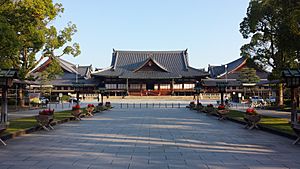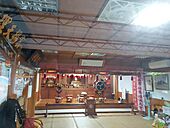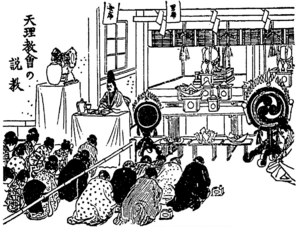Tenrikyo facts for kids
Quick facts for kids Tenrikyo |
|
|---|---|

Tenrikyo Church Headquarters in Tenri, Nara
|
|
| Type | Japanese new religion |
| Scripture |
|
| Theology | Tenrikyo theology (primarily features of monotheism) |
| Shinbashira | Nakayama Zenji |
| Associations | Tenrikyo Young Men's Association, Tenrikyo Women's Association |
| Region | Worldwide |
| Headquarters | Tenrikyo Church Headquarters |
| Founder | Nakayama Miki |
| Origin | 1838 Tenri, Nara |
| Separations | Honmichi, Honbushin, Tenrin-Ō Meisei Kyōdan, Daehan Cheolligyo |
| Hospitals | Tenri Hospital |
| Primary schools | Tenri Elementary School |
| Secondary schools | Tenri Middle School, Tenri High School |
| Tertiary schools | Tenri University |
| Publications | Publications by Tenrikyo Doyusha |
Tenrikyo (天理教, Tenrikyō) is a Japanese religion that started in the 1800s. It began with the teachings of a woman named Nakayama Miki. Her followers call her "Oyasama."
People who follow Tenrikyo believe that God, known by names like "Tsukihi" and "Tenri-Ō-no-Mikoto," shared divine messages through Miki Nakayama. The main goal of Tenrikyo is to teach and encourage a "Joyous Life." This happy way of living is achieved by being kind and helpful to others. This is called hinokishin.
Today, the main center for Tenrikyo is the Tenrikyo Church Headquarters. It supports many local churches in Japan. It also helps build and maintain the oyasato-yakata building. Tenrikyo has over 2 million followers around the world.
Contents
Core Beliefs of Tenrikyo
The main spiritual goal in Tenrikyo is to build the Kanrodai. This is a special pillar located at a place called the Jiba. Followers believe the Jiba is where human life began. Performing a special ritual around the Kanrodai is thought to bring happiness to everyone.
Going on a trip to the Jiba is like returning to your original home. This journey is known as "returning to O-Jiba" (おぢば帰り, o-jiba gaeri). That's why you might see "welcome home" signs in Tenri City.
Other important teachings include:
- Tannō (Joyous Acceptance) (堪能) – This means having a positive attitude even when facing problems or difficulties.
- Jūzen-no-Shugo – These are ten principles that helped create the world. They are believed to be always at work in the universe.
Living a Joyous Life
The Joyous Life in Tenrikyo means being kind and avoiding negative feelings. These feelings include greed, selfishness, hatred, anger, and pride. These negative thoughts are not called "sins." Instead, they are seen as "dust" that can be cleaned from the mind. This "dust" is swept away through hinokishin (voluntary effort) and prayer.
Hinokishin is done out of thanks, not to show off. It's a way to express gratitude for our bodies and for God's care.
Understanding Our Bodies
A basic teaching in Tenrikyo is kashimono-karimono. This means "a thing lent, a thing borrowed." It refers to the human body. Tenrikyo followers believe their minds are their own. However, their bodies are borrowed from God.
Understanding God in Tenrikyo
The sacred name for the one God and creator of the universe in Tenrikyo is Tenri-Ō-no-Mikoto (天理王命). Followers believe God created humans so they could live happily and share in that joy.
God's nature is explained in steps through the scriptures:
- First, as Kami (神, lit. spirit/god/deity). This was a familiar term for people in Japan.
- Second, as Tsukihi (月日, lit. Moon-Sun). Like the sun and moon give light and warmth, God's actions are fair and constant.
- Finally, as Oya (をや, lit. Parent). This shows that God loves humans like a parent loves their children. God guides and cares for people so they can live happily together.
Followers often call God "God the Parent" ("God the Parent" (Oyagami-sama)). They use the name "Tenri-O-no-Mikoto" when praying or worshipping.
Causality and Life's Events
In Tenrikyo, the idea of innen (いんねん (因縁), "causality") is similar to the idea of karma. It means that your actions and intentions affect your future. Good actions lead to good outcomes, and bad actions can lead to difficulties. This is like the saying, "every seed sown will sprout."
Tenrikyo teaches that when a person dies, their mind stops working. But their soul, through a process called denaoshi (出直し, lit. to make a fresh start), gets a new body and is reborn. Even though the reborn person doesn't remember their past life, their actions from before affect their new life.
Original Causality
A key idea is "original causality" (もとのいんねん (元の因縁), moto no innen). This means God created humans to live a Joyous Life and to share in that happiness. Tenrikyo believes that this Joyous Life will eventually include everyone.
Individual Causality
Individual causality means that God guides people through their experiences. Sometimes, suffering can be a way for God to encourage people to reflect and change their hearts. It's not seen as punishment. Instead, it's a chance to grow and work towards the Joyous Life. This leads to an attitude of tannō (たんのう (堪能), "joyous acceptance"). It means accepting situations with a positive mind, trusting in God's love.
Three Special Causalties
There are three special causalities that led to the start of Tenrikyo's teachings:
- Causality of the Soul of Oyasama: This refers to Miki Nakayama having the soul of the original mother from creation.
- Causality of the Residence: This means the Nakayama family home, where Tenrikyo Church Headquarters now stands, is the place where humankind was first created.
- Causality of the Promised Time: This points to October 26, 1838. This was the day God first spoke through Miki Nakayama. It marked a special time when a long period, equal to the number of first-born humans, had passed since creation.
Important Texts
Sacred Writings
The three main sacred writings of Tenrikyo are the Ofudesaki, Mikagura-uta, and Osashizu.
The Ofudesaki (おふでさき, "Tip of the Writing Brush") is the most important. It's a collection of 1,711 poems written by Miki Nakayama from 1869 to 1882.
The Mikagura-uta (みかぐらうた, "The Songs for the Service") contains the words for the Service (otsutome). This is a central religious ritual in Tenrikyo. During the Service, these songs are sung with dance and music, all taught by Nakayama.
The Osashizu (おさしづ, "Divine Directions") is a record of messages given by Izo Iburi. It contains about 20,000 "divine directions" from 1887 to 1907.
These texts guide followers. The Ofudesaki shares the main ideas of the faith. The Mikagura-uta comes alive through singing and dancing in the Service. The Osashizu gives clear rules for how followers should act.
Other Helpful Texts
There are also three official texts that help explain Tenrikyo's teachings:
- The Doctrine of Tenrikyo: This book explains the basic ideas of Tenrikyo.
- The Life of Oyasama, Foundress of Tenrikyo: This is the official story of Miki Nakayama's life.
- Anecdotes of Oyasama, Foundress of Tenrikyo: This book collects stories about Nakayama that were shared by her first followers.
Organization and Activities
Tenrikyo is made up of many different groups. They all share common goals but have different jobs. These groups include large churches, disaster relief teams, hospitals, universities, museums, and schools.
Tenri Judo is a famous style of Judo that has produced many champions. There are also other sports and arts groups within Tenrikyo.
History of Tenrikyo
In Tenrikyo tradition, Nakayama Miki became the "Shrine of God" in 1838. This happened after her son and husband became very ill. A Buddhist monk was called to help. When the monk left, Nakayama was possessed by God (Tenri-O-no-Mikoto). God asked that Nakayama be given to God as a shrine. Her husband agreed three days later.
Nakayama's messages were also supported by Izo Iburi, one of her first followers. He helped answer questions and gave "timely talks." His role was called Honseki. His messages were written down in the Osashizu books.
Between 1908 and 1945, Tenrikyo was recognized as one of thirteen groups within a type of Shinto. During this time, Tenrikyo was the first new religion in Japan to do social work. They opened an orphanage, a public nursery, and a school for the blind.
Today, Tenrikyo is separate from Shinto and Buddhism. However, it still uses many traditional Japanese religious practices. For example, some objects used in Tenrikyo services are similar to those used in traditional Japanese rituals.
Important Dates
- 1798, April 18: Miki Nakayama was born.
- 1838, December 12: God was revealed to Nakayama. This is considered the founding date of Tenrikyo.
- 1854: Nakayama began to offer a special blessing for safe childbirth. This helped her gain her first followers.
- 1866: The first parts of the Ofudesaki were written.
- 1887, January 26: Nakayama passed away.
- 1908: Tenrikyo was officially recognized as a branch of Sect Shinto.
Religious Services
Tenrikyo uses traditional musical instruments in its otsutome (おつとめ, lit. service or duty). These include wooden clappers (hyoshigi), cymbals (chanpon), gongs (surigane), drums (taiko, tsuzumi), flutes (fue), and string instruments (shamisen, kokyū, koto). These instruments play music from the Mikagura-uta. This is a collection of music, dances, and songs created by Nakayama.
Daily Services
The Otsutome (daily service) involves a seated service. It can also include practicing one or two chapters of the 12 chapters of Teodori (lit. hand dance) or Yorozuyo. This service is done twice a day, in the morning and evening. The times change with sunrise and sunset.
The daily service doesn't have to be done in a church. It can be done anywhere, as long as the person faces the Jiba. The goal of the daily service is to "sweep away" the "Eight Mental Dusts" from the mind.
What is Hinokishin?
Hinokishin (ひのきしん or 日の寄進) means "daily service." It's a spontaneous action that shows thanks and joy. It's done because followers are grateful to "borrow" their bodies from God. This action is ideally done to help others, without expecting anything in return.
Hinokishin can be anything from helping someone to simply smiling to make someone's day better. Common activities include cleaning public bathrooms or parks. Doing tasks that others don't want to do is seen as sincere by God.
Hinokishin helps to "sweep" away "mental dusts." These "mental dusts" are negative thoughts and feelings. The official names for these dusts are:
- Miserliness (Oshii) (being stingy)
- Covetousness (Hoshii) (wanting what others have)
- Hatred (Nikui) (strong dislike)
- Self-love (Kawai) (being too focused on oneself)
- Grudge-bearing (Urami) (holding onto anger)
- Anger (Haradachi) (feeling mad)
- Greed (Yoku) (wanting too much)
- Arrogance (Kouman) (being overly proud)
Groups like the Tenrikyo Young Men's Association and Tenrikyo Women's Association do public service activities. Participating in these groups is a form of Hinokishin.
Monthly Services
The Tsukinamisai (monthly service) is a full performance of the Mikagura-uta. This service is for the salvation of the world. At the main headquarters in Tenri City, this service is held on the 26th of every month. This date is special because Tenrikyo began on October 26, 1838.
All the instruments mentioned earlier are used in the monthly service. There are also dancers (three men and three women) and a singer. Performers wear traditional montsuki kimono.
Divine Grant of Sazuke
The Divine Grant of Sazuke is a healing prayer. People can receive it after attending nine special lectures. Once someone receives it, they are called a Yoboku (lit. useful timber). The Sazuke is used to pray for God's blessings for those who are sick.
For healing to happen, both the sick person and the person giving the Sazuke need to clean their minds of "mental dust." When both minds are pure, blessings can be received. It is taught that if both people are sincere, a wonderful healing will be given. This involves the sick person learning about the mental dusts and Tenrikyo teachings to improve their mind.
Tenrikyo Around the World

In recent years, Tenrikyo has grown outside of Japan. It has branches mainly in Southeast Asia and the Americas. Tenrikyo has centers in many countries, including:
- Argentina: Buenos Aires
- Australia: Calamvale, Melbourne
- Brazil: Bauru, Recife
- Canada: Vancouver
- France: Paris, Antony
- Hong Kong
- Mexico: Mexico City
- Philippines: Manila
- Singapore
- South Korea: Gimhae
- Taiwan: Taipei
- United Kingdom: Leeds, London
- United States: Los Angeles (US headquarters), Honolulu, Seattle, New York City, San Francisco
Notable People in Tenrikyo
- Ayaka Hirahara – A Japanese pop singer.
- Naoki Matsuyo – A Japanese association footballer.
Images for kids
-
Tenrikyo Church Headquarters in Tenri, Nara
-
Tenrikyo service performers wearing traditional montsuki kimono after a monthly service.
-
Tenrikyo shrine at Banqiao District, New Taipei City.
See also
 In Spanish: Tenrikyō para niños
In Spanish: Tenrikyō para niños













